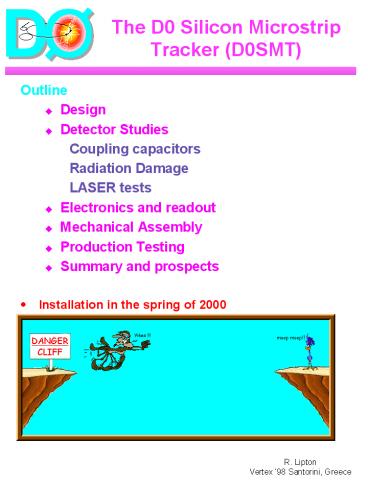The D0 Silicon Microstrip Tracker D0SMT - PowerPoint PPT Presentation
1 / 30
Title:
The D0 Silicon Microstrip Tracker D0SMT
Description:
Vertex 98 Santorini, Greece. F Disk. Silicon IR = 26 mm, OR = 105.27 mm at wedge centerline ... Vertex 98 Santorini, Greece. Capacitor Studies ... – PowerPoint PPT presentation
Number of Views:60
Avg rating:3.0/5.0
Title: The D0 Silicon Microstrip Tracker D0SMT
1
The D0 Silicon Microstrip Tracker (D0SMT)
- Outline
- Design
- Detector Studies
- Coupling capacitors
- Radiation Damage
- LASER tests
- Electronics and readout
- Mechanical Assembly
- Production Testing
- Summary and prospects
- Installation in the spring of 2000
2
D0SMT Components
- Major SMT Subsystems
- Single Sided Ladder (3 chip)
- Double Sided 2o Ladder (9 chip)
- Double Sided 90o Ladder (6 chip)
- H Disk (SS back-to-back)
- F Disk (DS)
3
Barrel/Disk Module
4
H DISK
- Silicon IR 94.5 mm, OR 236 mm at wedge
centerline - Readout mounts on outer silicon detector
- Wedges alternate between two surfaces of a
central cooling/support channel - Effective stereo angle 15o
5
F Disk
- Silicon IR 26 mm, OR 105.27 mm at wedge
centerline - Readout mounts outboard of silicon, which allows
disk to fit within a gap of 8 mm - Wedges alternate between two surfaces of a
centralcooling/support channel (beryllium) - Effective stereo angle 30 degrees
- p-side Trace angle -15o with respect to wedge
centerlinePitch 50 µm - n-side Trace angle 15o with respect to wedge
centerlinePitch 62.5 µm
6
Capacitor Studies
- In a double sided detector with grounded
electronics, coupling capacitor breakdown will
limit the lifetime of the detector. - Studies
- Eliminate black hole effect in the SVX chip by
bypassing parasitic transistor at the input (see
VTX 96) - Effect of wirebonding on capacitor breakdown
- 5-10 of capacitors fail at 50-100V after bonding
(normally Vbd140V) on SS detectors - No excess failures see on DS detectors with PECVD
layer
7
n-side Capacitor Studies
- When electronics are connected to the n-side of a
detector with shorted capacitors we see an
anomalous current from the amplifier input - Current is reduced when electronics is
disconnected - Effect seen on n-side only
- Caused by forward bias of the p-stop n junction
8
n-side Capacitor Studies
9
Irradiation Studies
- Expect 1 Mrad exposure for the inner layer per
4fb1 - Irradiation with
- 8 GeV Protons from the Fermilab booster
- 1 MeV Neutrons (Lowell Mass.)
- Study
- Evolution of deletion characteristics
- Performance of detector and electronics
10
Irradiation StudiesCluster size
11
Irradiation Studiesnoise
12
H Disk Irradiation
Depletion voltage (volts)
Neutron fluence (1013/cm2)
Neff (1011/cm3)
Neutron fluence (1013/cm2)
13
Neutron Studies
Detector Studies using 1 MeV neutron source
14
Irradiation StudiesLASER Plateau
15
Detector Production
- Five detector types - 3-chip, 9-chip, 6-chip, F
wedge, H wedge. - All radiation testing complete
- laser and cosmic ray studies
- Measure in-situ rise times
- charge sharing distributions
- Probe testing
- 100 V capacitor breakdown test on each channel
- CV or alpha test to measure depletion
- IV Test
- Spot checks on
- Interstrip resistance
- Coupling capacitance
- Strip currents
16
Micron Detector Delivery
Needed for schedule
Needed for schedule
17
Readout System
18
D0SMT - Electronics
- SVXII Chip - done and tested
- Most issues involve bypassing and clock quality
- Needs careful hybrid(HDI) design
- HDIs - delivery pacing production
- Single layer flex 4 mil pitch, 2 mil vias
- Cables
- low mass, good frequency response (53 Mhz), low
attenuation, no reflections, no radiation of
clock signal to the calorimeter, fits in the
allowed space. - High impedance stripline
- 3 segments
- low mass section of varying length
- low mass fixed length
- high mass high quality section
- System tests underway now
19
Where we were burned
- HDI flex circuit - good prototypes but no good
production circuits - Find reliable company (Dyconex)
- pay extra
- Detector delivery - ordered detectors 2 years
early but waited for BABAR, H1 - still a serious problem
- Cables
- low mass, high impedance striplines are
difficult - pay extra
- But we are now in production and expect to be on
schedule
20
Mechanical Systems
- Design Philosophy
- Build planar assemblies (ladders, wedges, disks)
precisely under (Zeiss) CMM - Use mechanical tolerances to determine ladder
placement in barrel (15 mm) - Minimum Mass
- Be support structures
- Carbon fiber overall support
21
Ladder Assembly
22
Module Assembly
23
(No Transcript)
24
Ladder Assembly
- Match notches in Be support to posts in bulkhead
- 15 micron tolerance on Notched and posts
- 2 micron tolerances achieved in ladders
Detector fiducials relative to beryllium notches
Transverse offset from nominal (µm)
25
Rise Time Studies
Use LASER to excite SSD, Monitor preamp
26
Production Testing
- HDI Burn-in
- Encapsulation
- HDI Spot-check
- Ladder assembly
- Ladder Spot-check
- Ladder repairs
- Ladder burn-in
- LASER Test
- Insertion into detector
27
Laser TestingChannel uniformity
28
Laser TestingChannel Gains
29
Ladder and HDI
30
Summary
- We have achieved
- low mass flex/beryllium hybrids
- SVX II chip, 53 MHz readout
- Minimal dead area
- Precise construction
- A workable double sided design for moderate
radiation doses - Now we just have to build another 787,968
channels































